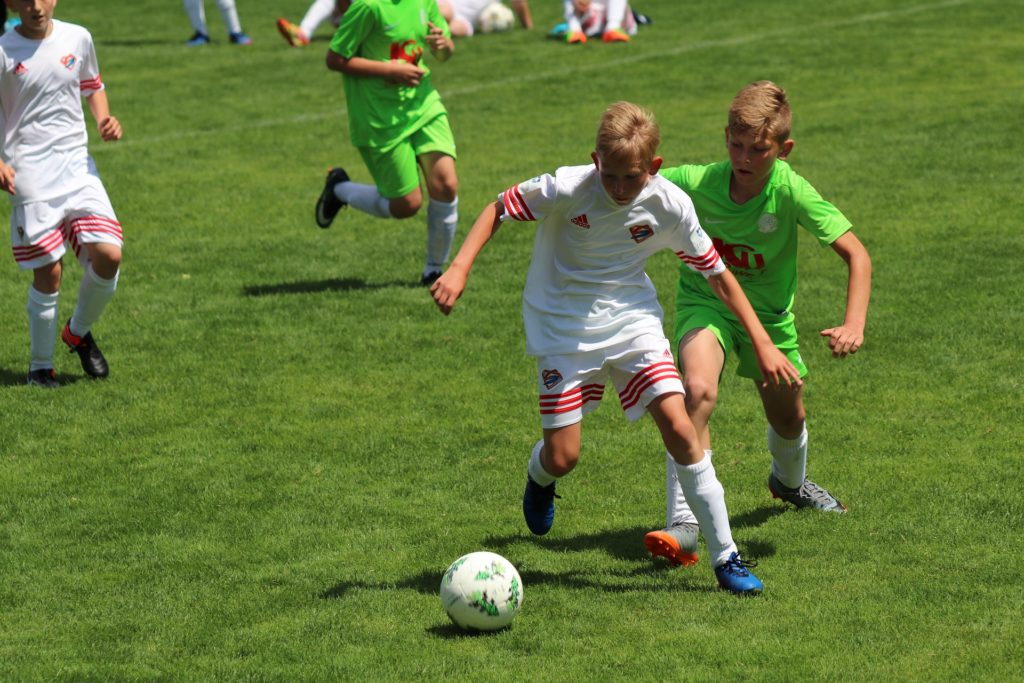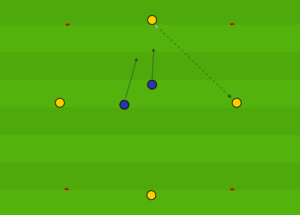For U8, please click here
Technical - Receiving the Pass

Check when moving to receive - to see if you can turn, take touch back, space to run into after touch, first time pass
Check when ball is traveling - to see if the picture has changed
Check/lift head after receiving - pass/dribble/shoot/move (if the ball was laid off first time)
Teaching players good body shape is also important. Though there are many situations when they can receive a ball in a game, ensuring an open body shape (the half-turn) enables so many benefits. Players have better vision of the field, they can determine which foot they receive with and it gives them better balance. I recall being an assistant to a coach who yelled at a player to "be stronger" when an opponent stepped in front of him and intercepted the pass. My argument was that the player should have been on the half-turn. He would have seen the opponent coming and been able to hold him off by being side on, due to the better balance he would have had.
Game - Ajax Passing Diamond

Set up a 12 x 12 diamond. Place a minimum of 2 players per cone. Start with 1 ball. The player with the ball passes to the right. The receiving player makes a double movement; step away from the ball and then towards to receive. The passing player follows their pass and the receiving player takes their first touch and then passes to the next player. Continue.
Progression
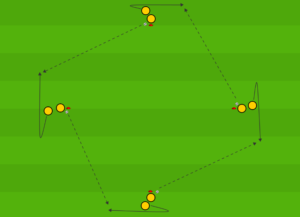
Add a second ball. If players become comfortable with that, add a 3rd and 4th ball.
Why it works
The set up of the diamond provides realistic angles for the players to provide when receiving. Players get to repeat the 3 times they look away from the ball consistently. Players will look to receive on the back foot, though as a coach it can be adapted to work on different receving and passing combinations (back foot only, back foot-front foot, front foot only, outside-inside). The increase in balls forces game like speed and players have to think quickly to remember everything they should be doing.
Tactical - Support
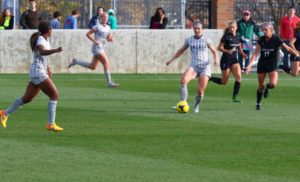
By the culmination of U8, our players hould have a good understanding of width. They will have also learned, with the correct practice, that there is more than one direction that they can go forward in. Added to increased social development, U10 is an ideal age to target the support principle of attacking play.
Small sided games are an excellent way of developing this understanding. I am a big fan of zonal SSG's - breaking the field into thirds or quarters and allowing players to create attacking overloads against the opposition. In a similar manner to the U8's, it is important we don't bring in too much too soon. The visualisation of a U10 is a lot less than that of an adult, especially an adult who has the benefit of seeing the whole picture from the outside.
Overloads of 3 v 1, 3 v 2 and 4 v 2 allow for players on the ball to have 2/3 supporting options - left, right and through the gap.
Game - Thirds
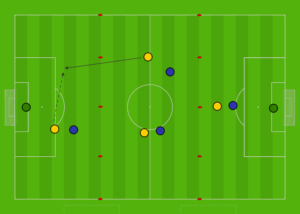
Set up an appropriately sized field, broken into thirds. Both teams play 1-2-1 (adapt according to your numbers). The team out of possession must remain in their thirds. The players in possession are allowed to move and create a one player overload in the set third. Teams can only score in the attacking third and the ball can only travel through by passing.
Progression
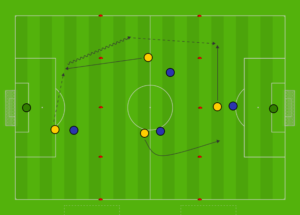
Players can now travel with the ball into the next third.
Why it works
The thirds give players an easily understandable visual aid. The middle third is often the most congested in games and is represented as such. The middle third gives the option for either the defender to push up or the striker to drop deep, thus decision-making as a team. Players must decide whether to play forward or drop the ball to build attack again. The progression encourages support for a number of opportunities to penetrate.
Social - Group Interaction

At U10, children are becoming more used to working together in small groups. Part of this is peer pressure, which as a result gives U10's the need of belonging. This allows coaches to target practices towards a possession style of play. Players are no longer as concerned about getting their "toy" back and have a greater understanding of patience.
With group formation becoming more natural, this also means that leaders are starting to surface. I have read a lot of comments about having a team captain recently. Specifically, whether a team should have a set captain. At this age, it really provides no benefit. At Premier League level, the captain is the manager's voice on the pitch. His fellow players have the experience to understand and accept that.
Even though U10's are becoming more accepting of group dynamics, internal thoughts are still present. To the eyes of a 9/10 year old, it appears as though the coach is adopting favouritism and for the player selected, motivation will suffer, knowing they are guaranteed a start. Children with no siblings can struggle with this especially (I'm talking from experience!). Also, leaders will always be leaders, armband or not. Players of an introverted nature will benefit from a day as a captain. Their leadership skills will be able to develop, leaving you with a team of leaders going forward.
Game - 4 v 2
Set up a 10 x 10 square. 4 players are on the outside, covering a side of the square each. They can move up and down this line. 2 players are inside the square, acting as defenders. If the 4 make 3/5 consecutive passes, they get a point. If the defenders win the ball, they look to dribble out of the square to score a point. Rotate defenders every 2/3 minutes.
Progression
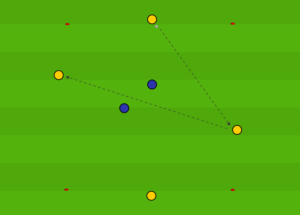
The possession team can score a point by 3/5 passes or by splitting the defenders.
Why it works
From a leadership point of view, players are all facing each other, giving the players off and away from the ball the chance to communicate. The progression into offering points for a split pass and a combination of sideways passes allows the picture to be painted for one of the big reasons why we keep the ball - to move defenders and create spaces to play through them. Defenders are given a realistic target to score points.
Physical - Stretches
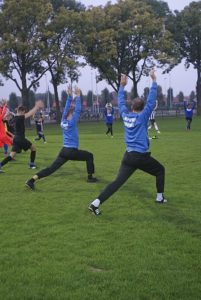
During a trip to the Ajax Academy, the sports scientist gave a small discussion about players biological age. We were shown pictures of 3 players, all aged 14. Despite being the same age, one had the genetic make up of a 16/17 year old and another had the build of an 11/12 year old. This meant that they were able to push the players differently based on their biological age as opposed to their birth age.
Differences in biological age also happens at the U10 age group. Living in the US especially, I lost count of the amount of U10 players I saw who were nearly as tall as me! Unlike with Ajax, who have numerous coaches per team, we have to make sure our practices suit the needs of every player.
At U8, players are as flexible as they will ever be. The need for stretches is unecessary and, if you can remember being that age, boring. It is also hugely unlikely to see a U8 injured from a muscular pull. At U10, children start to lose their flexibility. This doesn't happen to all of them, as some players will have the biological age of an 8 year old. Some may also have the body of a 12 year old, so introducing some dynamic movements will aid them greatly. It also gets players into the mindset of stretching prior to exercise.
An additional note for coaches of females. Females are 5 times more likely to have an ACL tear than males. For those of you who coach girls, adding some leg/knee strengthening exercises is also advisable.
Game - Circle Passing
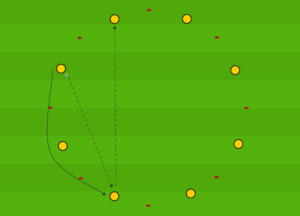
Form a circle with all players standing around the outside. The player with the ball passes to any team mate and jogs around the outside of the circle to take the place of the player who was passed to. Change dynamic movements every 60 seconds - high knees, butt kicks, lunges, side steps etc
Progression
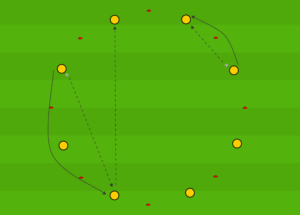
Add a 2nd ball.
Why it Works
The ball gives players to keep their attention span and use the creativity - passes can be varied. Players also start communicating as soon as practice starts. The increase in balls increases the speed of movements gradually, something that all warm ups should incorporate.

